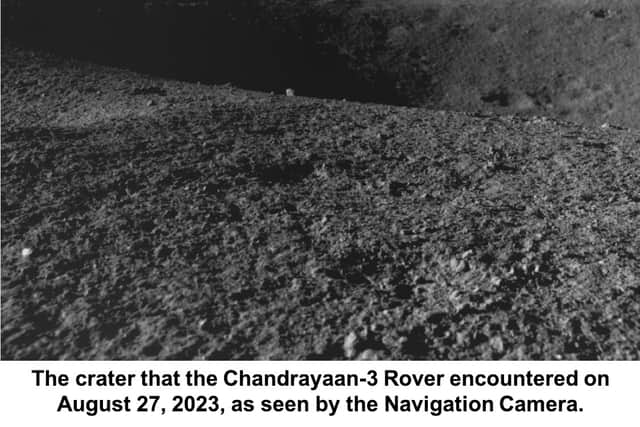Chandrayaan-3: India's Moon rover finds sulphur and navigates craters on the lunar surface
and live on Freeview channel 276
Pragyaan, India's Moon rover, has confirmed the presence of sulphur and other elements near the lunar south pole.
The rover’s laser-induced spectroscope instrument detected aluminium, iron, calcium, chromium, titanium, manganese, oxygen and silicon on the lunar surface, the Indian Space Research Organisation (ISRO) said.
Advertisement
Hide AdAdvertisement
Hide AdThe Chandrayan-3 Rover is expected to conduct experiments over 14 days, as it searches for signs of frozen water that could help future astronaut missions, as a potential source of drinking water or to make rocket fuel.


The rover also will study the moon’s atmosphere and seismic activity.
As the rover roams around the mission's landing point, named the Shiv Shakti point, it has covered a quite a distance. Pragyaan travels at a speed of 1cm per second, and now has covered a distance of eight meters.
On Sunday, the rover’s route was reprogrammed when it came close to a four-metre-wide (13-feet) crater.
“It’s now safely heading on a new path,” the ISRO said.
Advertisement
Hide AdAdvertisement
Hide AdAfter a failed attempt to land on the moon in 2019, India last week joined the US, the Soviet Union and China as only the fourth country to achieve this milestone.
The mission began more than a month ago at an estimated cost of 75 million dollars (£59.4 million).
India’s success came just days after Russia’s Luna-25, which was aiming for the same lunar region, spun into an uncontrolled orbit and crashed.
It would have been the first successful Russian lunar landing after a gap of 47 years.
Advertisement
Hide AdAdvertisement
Hide AdRussia’s head of the state-controlled space corporation Roscosmos attributed the failure to the lack of expertise due to the long break in lunar research that followed the last Soviet mission to the moon in 1976.
Active since the 1960s, India has launched satellites for itself and other countries, and successfully put one in orbit around Mars in 2014. India is planning its first mission to the International Space Station next year, in collaboration with the United States.
Comment Guidelines
National World encourages reader discussion on our stories. User feedback, insights and back-and-forth exchanges add a rich layer of context to reporting. Please review our Community Guidelines before commenting.
